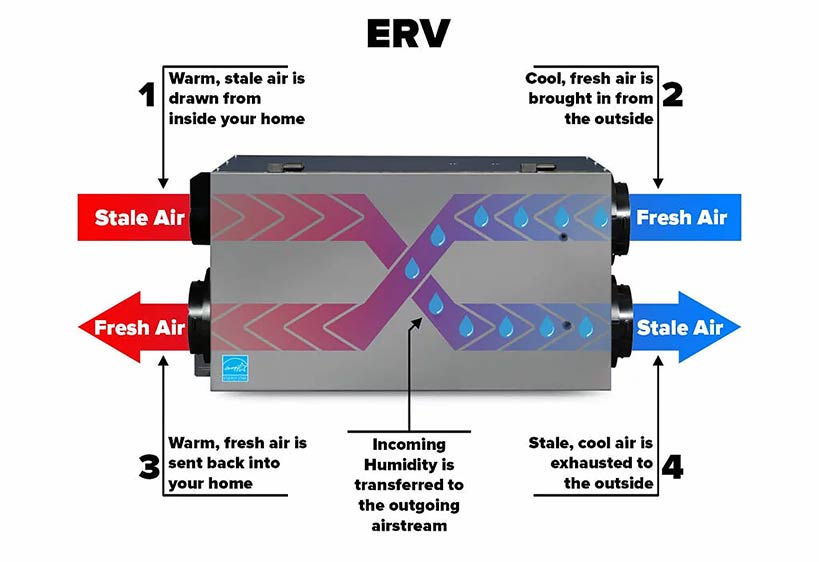What is an ERV and How Does It Work?
An ERV, or Energy Recovery Ventilator, is a mechanical system designed to improve indoor air quality while minimizing energy loss in buildings. It works by exchanging stale indoor air (Return Air) with fresh outdoor air, all while transferring heat and sometimes moisture between the two air streams to maintain a comfortable indoor environment. This makes it especially useful in energy-efficient homes, commercial buildings, or climates with extreme temperatures.
Here’s how it works in simple terms:
Air Exchange: An ERV has two air streams—one pulling fresh air from outside into the building, and another pushing stale air from inside to the outside. These streams pass through the system simultaneously but don’t mix directly.
HEX Core: At the heart of an ERV is a heat-exchange core (often made of materials like aluminum or specialized polymers). As the outgoing air passes through this core, it transfers its heat to the incoming air. In winter, for example, warm indoor air heats up the cold incoming air. In summer, the reverse happens—cool indoor air reduces the temperature of hot incoming air.
Moisture Transfer (in some ERVs): Unlike a basic heat recovery ventilator (HRV), many ERVs also manage humidity. They use a desiccant or permeable membrane in the core to transfer moisture. In humid climates, this prevents excess dampness indoors; in dry climates, it helps retain some indoor humidity.
Fans and Filters: The system uses fans to move the air and filters to clean the incoming air, removing dust, pollen, or pollutants before it enters the building.
Energy Savings: By pre-conditioning the incoming air with the energy from the outgoing air, the ERV reduces the workload on heating or cooling systems, cutting energy costs—sometimes recovering 70-80% of the energy that would’ve been lost in traditional ventilation

Energy Recovery Ventilators (ERVs) use different processes to transfer heat and moisture:
- Sensible Heat Recovery
Sensible heat recovery transfers thermal energy between supply and exhaust air streams without affecting moisture levels. As the two air streams pass through a heat exchanger, heat moves from the warmer to the cooler stream. In winter, for instance, heat from the warm exhaust air pre-heats the cold supply air before it enters the building, thereby reducing heating costs. This process is ideal for climates where temperature control is the primary concern, and humidity control is less critical. Sensible heat recovery systems typically achieve efficiencies between 50% and 80% depending on the type of heat exchanger core used.
- Latent Heat Recovery
Latent heat transfers moisture between air streams to regulate humidity. The heat exchanger allows moisture to move from the more humid to the drier stream. In summer, for example, moisture from the humid outdoor air is transferred to the drier exhaust air, reducing the humidity of incoming air. This process is essential in humid climates where maintaining comfortable indoor humidity levels is crucial for both health and efficiency. Latent heat recovery systems can achieve moisture transfer efficiencies of 50% to 70%. depending on the type of heat exchanger core used.
Some of the benefits of using ERVs are:
- Improved Indoor Air Quality: Continuous ventilation removes pollutants and allergens, ensuring a healthier indoor environment.
- Energy Efficiency: Reduces the energy required for heating and cooling by recovering energy from exhaust air.
- Sustainability: Lowers the carbon footprint of buildings by reducing energy consumption.
By recovering energy from exhaust air, ERVs significantly reduce the load on HVAC systems, ensuring optimal indoor air quality and quality comfort without compromising energy efficiency. This makes ERVs an ideal choice for maintaining a healthy, comfortable, and cost-effective indoor environment.
Sources:
- https://www.ashrae.org/technical-resources/energy-recovery
- https://bsesc.energy.gov/energy-basics/hvac-energy-recovery-ventilation
- https://www.engineeringtoolbox.com/heat-recovery-efficiency-d_201.html
- https://www.ashrae.org/file%20library/technical%20resources/covid-19/si_s20_ch26.pdf
- https://www.ahrinet.org/scholarships-education/education/contractors-and-specifiers/hvacr-equipmentcomponents/air-air-energy-recovery-ventilators-ervs
Disclaimer:
The information provided in this document is for general informational purposes only and is based on industry knowledge at the time of writing. While we strive for accuracy, we do not guarantee the completeness, reliability, or suitability of the content for any specific application. Performance, efficiency, and compliance may vary based on system design, environmental conditions, and regulatory updates. Readers are encouraged to consult manufacturers, industry professionals, or relevant authorities for precise guidance. Caeli Group Pty Ltd disclaims any liability for any loss or damage arising from the use of this information.

